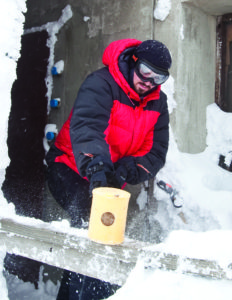5 risks to look out for in chilly workplaces
From a building site in the middle of winter to a cold storage facility in the food industry, work can sometimes be a chilly business.
When it comes to cold-proof personal protective equipment (PPE), gloves and thermal workwear may be the first items that spring to mind, but protecting the eyes is just as important.
Here, Stephanie Quilliet, strategic product leader-EMEA, Head and Body, Honeywell Industrial Safety, looks at five risks to the eyes that it’s worth watching out for when the temperature drops.

Risk 1: Fogging lenses
Fogging is the number one challenge workers face when wearing safety eyewear and is especially a problem in cold environments. One dangerous consequence of fogged up lenses is that a worker may not be able to see properly and so miss their step, which can be fatal if, for example, they are working at height. On the other hand, obscured vision may lead workers to remove eyewear to wipe their lenses clear and put themselves at risk of serious injury.
Tip: Select eyewear with an anti-fog coating – along with top and bottom ventilation to enhance airflow – to significantly reduce fogging and provide anti-scratch performance to keep lenses clear and workers safe.
Risk 2: Eye discomfort
Tears play a key role in lubricating the eye and protecting it by flushing out any dust and dirt. Yet, when the weather gets particularly cold and windy, the eyes may not be able to produce enough tears to protect themselves against rain, snow or other flying particles. As a result, they can dry out and become red, swollen and irritated, causing discomfort [1].
Tip: Use goggles with a wide, adjustable headband to provide a safe and comfortable fit to better protect your eyes when working outdoors for prolonged periods of time.
Risk 3: Snow blindness
Winter is not always the sunniest of seasons. Yet, exposure to bright sunlight reflected from snow or ice can result in photokeratitis, also known as snow blindness. Excessive exposure to such ultraviolet (UV) light can temporarily damage the cells on the eye surface, causing symptoms including swelling, pain and blurred vision [2].
Tip: Choose suitable lens tints, such as grey, to help reduce the risk of snow blindness.
Risk 4: Blurred vision
As mentioned earlier, tears are important, but working in cold environments without appropriate eye protection can result in excess tearing or red swollen eyes – a consequence of constricted blood vessels in the tissues around the eyes – which can result in blurred vision [3].
Tip: Wear goggles to guard against wind and flying particles and provide extra face coverage.
Risk 5: Uncomfortable (and not so pretty) eyewear
Risks can also occur if workers are asked to wear goggles that they find uncomfortable or, perhaps, not fashionable. As a result, they are more likely to doff their eyewear and expose their eyes to the risks described above, not to mention dangerous substances they may be exposed to in environments such as building sites or offshore platforms.
Tip: Provide workers with goggles that include wide, adjustable headbands and a cool, skiwear-inspired look to encourage them to keep their eyewear on at all times during their shift.
To find out more about Honeywell’s new Sub-Zero™ goggles for superior protection in cold environments visit https://hwll.co/SubZeroGoggles.
References
- https://www.nhs.uk/conditions/dry-eyes/
- https://www.college-optometrists.org/guidance/clinical-management-guidelines/photokeratitis-.html
- http://discoveryeye.org/winter-weather-and-your-eyes/
5 risks to look out for in chilly workplaces
From a building site in the middle of winter to a cold storage facility in the food industry, work can
Safety & Health Practitioner
SHP - Health and Safety News, Legislation, PPE, CPD and Resources Related Topics
Winter-related hazards – Protecting your workplace this Christmas
71% of workers in the UK do not feel completely safe in their buildings, according to study
New cloud-based solution launched to provide connectivity and visibility to fire safety systems

